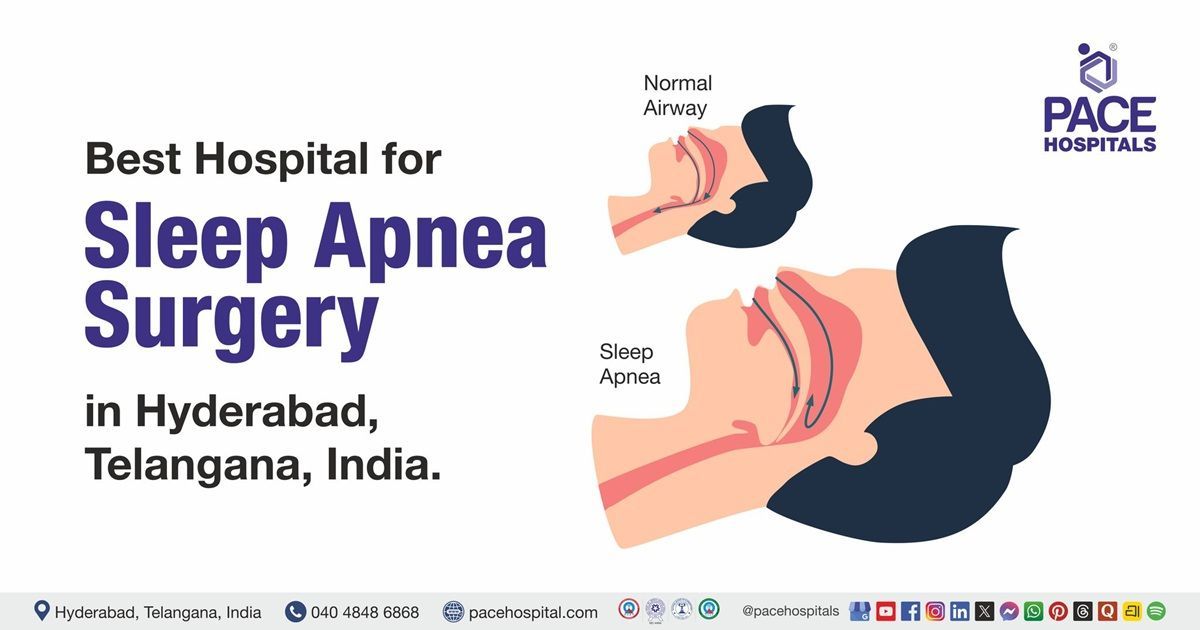Gilbert Syndrome - Causes, Symptoms, Diagnosis, and Treatment
Gilbert syndrome definition
Gilbert syndrome is defined as a common genetic disorder that affects the metabolism of bilirubin in the liver. It is an autosomal recessive condition that leads to mild to moderate unconjugated hyperbilirubinemia (increased levels of bilirubin in the blood), it is often presented as recurrent jaundice episodes.
Common factors such as fasting, febrile illness, hemolytic reactions, and menstruation can trigger high levels of bilirubin in the blood.
Gilbert syndrome is managed by
hepatologists and
gastroenterologists.
Gilbert syndrome meaning
The original name for this disease condition “La Cholemie Simple Familiale” was given by Gilbert, Castaigne, and Lereboullet in the early 1900, and it was described as an asymptomatic elevation of bilirubin. It was studied by several famous physicians including the Dutch biochemist Van den Bergh and the Danish physician Jens Einar Meulengracht. Many names were proposed for this condition including hereditary non-hemolytic bilirubinemia, familial non-hemolytic jaundice, and constitutional hepatic dysfunction. Today, Gilbert syndrome is the universally accepted name for this condition.
Gilbert syndrome prevalence
Prevalence of Gilbert syndrome worldwide
The prevalence of Gilbert syndrome is between 4% and 16 % but this rate can differ depending on an individual’s ethnic ancestry (cultural or ethnic origin) In America, the prevalence is estimated to be 2 % to 10% whereas in Japan and East Asia, it is estimated to be around 2%.
Prevalence of Gilbert syndrome in India
In India, the prevalence of Gilbert syndrome is about 20 %. In males’ differences in concentrations of sex steroid and higher bilirubin concentration account for the higher prevalence. Clinical manifestations present more often in early adolescence and are generally seen in men.
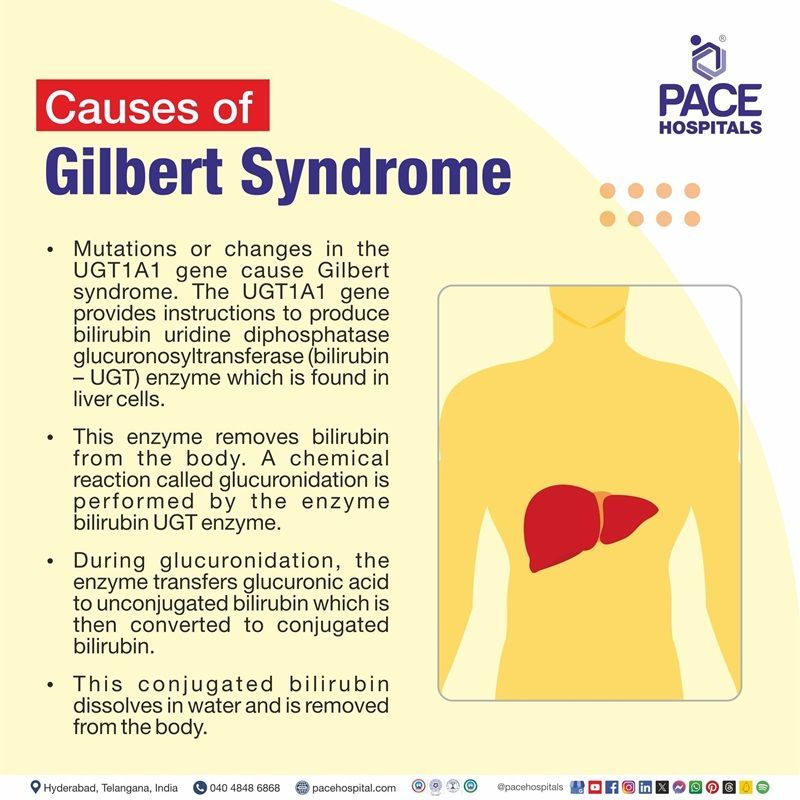
Gilbert's syndrome causes
Mutations or changes in the UGT1A1 gene cause Gilbert syndrome. The UGT1A1 gene provides instructions to produce bilirubin uridine diphosphatase glucuronosyltransferase (bilirubin – UGT) enzyme which is found in liver cells. This enzyme removes bilirubin from the body.
A chemical reaction called glucuronidation is performed by the enzyme bilirubin UGT enzyme. During glucuronidation, the enzyme transfers glucuronic acid to unconjugated bilirubin which is then converted to conjugated bilirubin. This conjugated bilirubin dissolves in water and is removed from the body.
The most common genetic mutation that causes Gilbert syndrome (called UGT1A1*28) in many populations develops in an area near the UGT1A1 gene called as promoter region. This promoter region controls the production of the bilirubin UGT enzyme. The genetic mutation impairs enzyme production. In Asians, a gene mutation changes a single protein building block known as an amino acid. This type of mutation results in decreased enzyme function and is known as missense mutation.
Unconjugated bilirubin is not glucuronidated quickly as people with Gilbert syndrome have 30 % of normal bilirubin UGT enzyme function. As a result, unconjugated bilirubin accumulates in the body causing mild hyperbilirubinemia.
Not everyone with Gilbert syndrome develops hyperbilirubinemia, which indicates that other factors hinder the glucuronidation process and contribute to the condition. For instance, red blood cells may break down and release excess levels of bilirubin. Alternatively, the passage of bilirubin into the liver where it should be glucuronidated gets impaired.
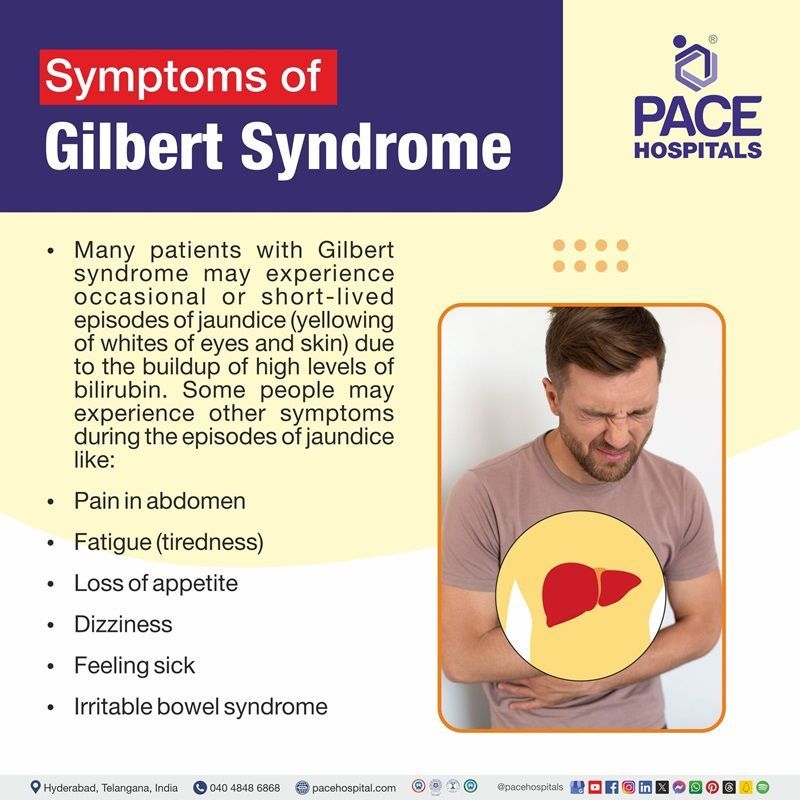
Gilbert's syndrome symptoms
Many patients with Gilbert syndrome may experience occasional or short-lived episodes of jaundice (yellowing of the whites of eyes and skin) due to the buildup of high levels of bilirubin. The yellowing due to jaundice is mild, as Gilbert syndrome causes a slight increase in bilirubin. Some people may experience other symptoms during episodes of jaundice such as:
- Pain in abdomen
- Fatigue (tiredness)
- Loss of appetite
- Dizziness
- Feeling sick
- Symptoms of
Irritable bowel syndrome (IBS)
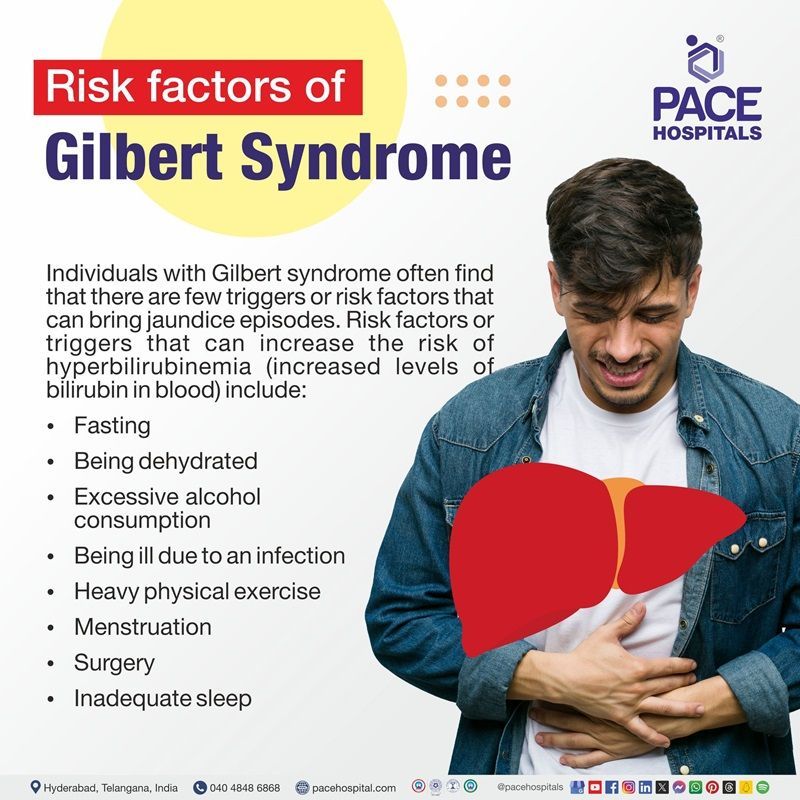
Gilbert's syndrome risk factors
Individuals with Gilbert syndrome often find that there are few triggers or risk factors that can bring jaundice episodes. Risk factors or triggers that can increase the risk of hyperbilirubinemia (increased levels of bilirubin in blood) include:
- Fasting: Intermittent fasting causes a 2-3-fold increase in unconjugated bilirubin in individuals with Gilbert syndrome.
- Being dehydrated: Bilirubin levels increase following dehydration.
- Excessive alcohol consumption: Excessive consumption of alcohol increases bilirubin levels.
- Being ill due to an infection: Bilirubin levels increase following any illness
- Heavy physical exercise: Extreme physical activity and stress trigger hyperbilirubinemia
- Menstruation: Menstruation causes fluctuation in bilirubin levels.
- Surgery: In patients who have undergone surgery, bilirubin levels may raise temporarily
- Inadequate sleep: Lack of sleep is considered a form of stress that can increase bilirubin production.
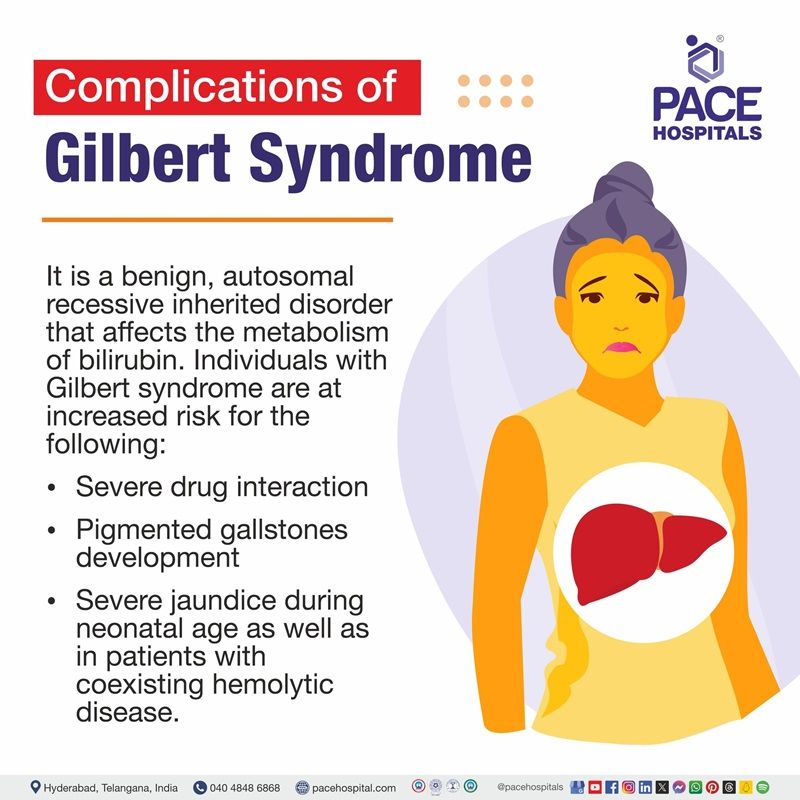
Complications of Gilbert syndrome
It is a benign, autosomal recessive inherited disorder that affects the metabolism of bilirubin. Individuals with Gilbert syndrome are at increased risk for the following:
- Severe drug interactions
- Pigmented gallstones development
- Severe jaundice during neonatal age as well as in patients with coexisting hemolytic disease.
There are no proven complications of Gilbert syndrome. It is not a risk for progressive liver disease or liver related mortality.
Gilbert syndrome diagnosis
In the majority of cases, Gilbert syndrome is so mild that there are no symptoms. However, medical investigation is necessary as this condition is associated with symptoms similar to serious liver disease. Diagnosis of Gilbert syndrome includes the following:
- Review of the medical history
- Physical examination of the patient
- Complete blood count and other necessary blood tests: To measure levels of bilirubin in blood.
- Urine test
Gilbert syndrome is correlated with an isolated unconjugated hyperbilirubinemia, with a serum total bilirubin of up to 4 mg/dL. This syndrome can be diagnosed by a blood test which measures levels of bilirubin in serum and liver function tests.
Liver function test
The liver releases enzymes in the blood when it gets damaged, at the same time protein levels begin to drop. Liver functionality can be estimated by measuring the levels of these enzymes and proteins. If liver function test results show high levels of bilirubin in the blood and the liver shows normal function, then a confirmed diagnosis of Gilbert syndrome can be made.
Genetic testing
Genetic testing can be performed with assays of UGT1A1 activity and polymerase chain reaction (PCR). It is performed to identify gene polymorphism and can be considered in case of diagnostic uncertainty, especially when certain drugs may affect UGT1A1 activity.
Gilbert syndrome treatment
Treatment is not required in individuals with Gilbert syndrome, as the condition is self-limiting (It resolves on its own within a few weeks). Management generally consists of reassuring patients and their families that this is a benign condition and does not require further testing and treatment.
Difference between Gilbert syndrome and Crigler Najjar syndrome
Gilbert syndrome v/s Crigler Najjar
Gilbert syndrome and Crigler Najjar syndrome are both inherited disorders that affect the conjugation of bilirubin, but they have some key differences. The following are some of the parameters that differentiate Gilbert syndrome and Crigler Najjar syndrome:
| Parameters | Gilbert syndrome | Crigler najjar syndrome |
|---|---|---|
| Definition | It is a common genetic disorder that affects the metabolism of bilirubin in the liver. It often leads to mild to moderate hyperbilirubinemia (increased bilirubin levels in blood). | It is a rare autosomal recessive inherited disorder which leads to non-hemolytic jaundice. |
| Symptoms | It is asymptomatic and generally presented as recurrent episodes of jaundice. | Confusion, yellowing of skin, yellowing of whites of eyes (jaundice), vomiting, poor appetite. |
| Causes | Mutations or changes in the UGT1A1 gene cause Gilbert syndrome. | It is caused by the absence or decreased level of UGT enzyme due to a genetic defect in bilirubin UDP glucuronosyltransferase family 1 polypeptide A1 gene. |
| Treatment | Treatment is not required as this condition is self-limiting. | Primary treatment focuses on lowering the levels of unconjugated bilirubin through phototherapy and plasmapheresis. Liver transplantation is the only curative treatment for type 1 Crigler najjar syndrome. |
Frequently Asked Questions (FAQs) on Gilbert syndrome
Is there any treatment for Gilbert syndrome?
No, there is no specific treatment for Gilbert syndrome. Gilbert syndrome is a condition that is asymptomatic, and it is a self-limiting condition that does not require any treatment.
Does alcohol increase the risk of Gilbert syndrome?
Yes, alcohol can increase the risk of developing Gilbert syndrome. Gilbert syndrome is an autosomal recessive condition characterized by hyperbilirubinemia (increased bilirubin). Excessive alcohol consumption increases bilirubin levels thereby increasing the risk.
How long does Gilbert syndrome last?
Gilbert syndrome is a condition that lasts for a lifetime. It does not pose any threat to health nor cause any complications or damage to the liver.
Does Gilbert's syndrome cause weight loss?
Yes, Gilbert syndrome, or more precisely hyperbilirubinemia can result in weight loss. Studies on bilirubin induced transcriptome responses showed that it acts selectively via PPAR alpha (peroxisome proliferator-activated receptor) inducing transcription of genes. This gene transcription activates mitochondrial function to utilize fats for energy and reduces body weight.
Does stress cause Gilbert syndrome?
Stress does not directly cause Gilbert syndrome, but it can trigger episodes of jaundice (jaundice being the primary symptom of Gilbert syndrome) in patients with Gilbert syndrome.
Is Gilbert syndrome curable?
No, there is no cure or treatment for Gilbert syndrome. It is a lifelong condition that does not require any treatment as it is not life threatening and does not cause any damage to the liver nor lead to complications.
How to diagnose Gilbert syndrome?
The diagnosis of Gilbert syndrome includes a blood test to measure the levels of serum bilirubin, a liver function test, and genetic testing. Enzymes are released into the blood when the liver gets damaged. At this time the levels of proteins produced by the liver begin to drop. By comparative measurement of levels of these enzymes and proteins, how well a liver is functioning can be estimated. A confirmed diagnosis of Gilbert syndrome can be made when there is a rise in serum bilirubin levels with normal liver function.
How to manage Gilbert syndrome?
Individuals with Gilbert syndrome do not require treatment as this condition is self-limiting and is not life threatening. Management generally involves reassuring patients and their caretakers that this is a benign condition that does not require further testing.
What is the genetic test for Gilbert syndrome?
Genetic testing of the UGT1A1 is performed to facilitate diagnosis of Gilbert syndrome. In this test, DNA is extracted from the blood sample of patient with unconjugated hyperbilirubinemia, and after amplification of polymerase chain reaction (PCR), the UGT1A1 gene is sequenced. The known pathogenic variants were identified after alignment with reference sequences and the variant spectrum was analyzed.
Which enzyme is deficient in Gilbert syndrome?
Gilbert syndrome is caused by the deficiency of the enzyme uridine diphosphate glucuronosyltransferase (UGT). This enzyme converts unconjugated bilirubin to conjugated bilirubin by transferring glucuronic acid to unconjugated bilirubin.
Is Gilbert's syndrome a disability?
Yes, Gilbert syndrome is a disability. Many medical evidence demonstrates that it is a disability in which the hereditary enzyme results in serum bilirubin elevation. Veterans’ disability (VA) has been evaluated by analogy to the rating criteria of chronic liver disease.
Share on
Request an appointment
Fill in the appointment form or call us instantly to book a confirmed appointment with our super specialist at 04048486868



